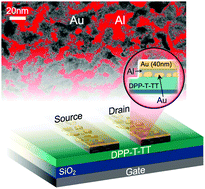Universal electrode for ambipolar charge injection in organic electronic devices†
Abstract
Ambipolar transistors, i.e. transistors with symmetrical n- and p-type performances, open new avenues for the design and integration of high-density, efficient and versatile circuits for advanced technologies. Their performance requires two processes: efficient injection of holes and electrons from the metal electrodes into the semiconductor; and transport of both carriers through the semiconductor. Organic semiconductors (OSCs) support ambipolar transport, but charge injection is strongly asymmetric due to inherent misalignment of the electrode work function with both conducting levels of the OSC. Here we introduce a new electrode concept capable of efficiently injecting both types of charge carriers into OSCs. The electrode has a mosaic-like structure composed of islands of two metals with high and low work functions, in this case Al and Au, respectively. Under suitable applied bias the Au (Al) domains in direct contact with the OSC allow efficient hole (electron) injection into the HOMO (LUMO) level. Implementing this electrode as both the source and drain in an organic field effect transistor (OFET) led to fully balanced ambipolar performance while maintaining high ON/OFF ratios. We then used the ambipolar OFETs to significantly simplify the circuit design and fabricate digital and analogue elements, i.e. a digital inverter and an analogue phase shifter using one type of transistor only. Finally, we demonstrate that a single ambipolar OFET can replace several unipolar transistors to fabricate digital transmission gate circuits. The new electrode design concept can include other metal combinations and compositions to balance ambipolar injection, and the use of the mosaic electrodes can be extended to other electronic devices that require ambipolar charge injection such as light emitting transistors, memory devices etc.

- This article is part of the themed collections: Materials Horizons 10th anniversary regional spotlight collection: Africa and the Middle East, Editor’s Choice collection: Organic Electronics and Special issue in honour of Seth Marder


 Please wait while we load your content...
Please wait while we load your content...